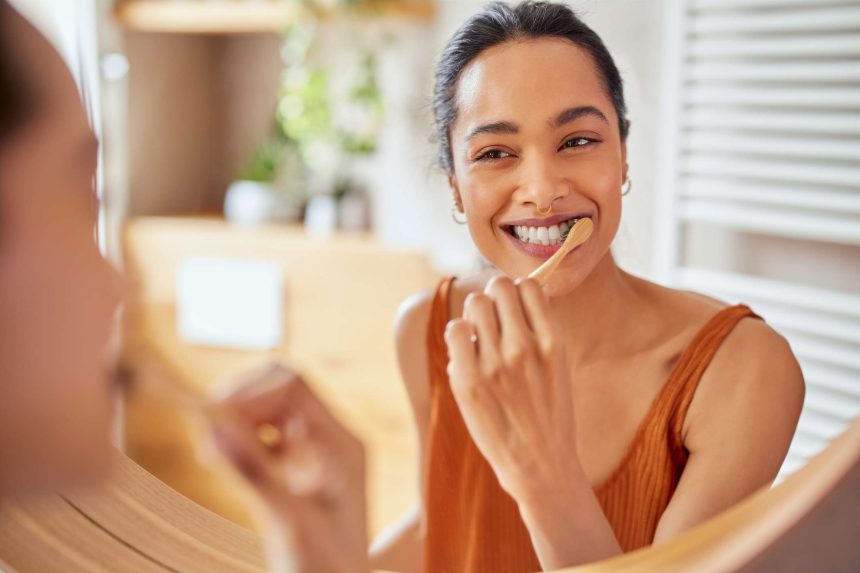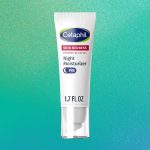Tooth discoloration is a common issue that millions of people attempt to address each year. Research shows that as many as 80% of adults ages 18-49 want whiter teeth. However, not everyone can afford expensive, in-office treatments.
People sometimes look for natural methods to address tooth discoloration, but not every natural technique is safe or effective for teeth whitening.
Oil pulling, an ancient remedy used to improve oral hygiene and remove toxins from the body, is one possible solution for naturally whitening teeth.
Whitening teeth with oil pulling involves swishing an oil, like coconut oil, in your mouth to try to remove bacteria. Bacteria left in your mouth can turn into plaque, which causes a yellow tint on your teeth.
Several studies have found that oil pulling reduces bacteria, plaque buildup, and gingivitis, all of which can cause teeth to yellow. One study found that swishing daily with coconut oil significantly reduced the bacteria Streptococcus mutans after two weeks. The researchers noted that oil pulling was as effective as an antimicrobial mouthwash.
Hydrogen peroxide is a common ingredient used in whitening products. It removes stains, dissolves compounds that make your teeth look yellow, and has strong bleaching capabilities. One study found that hydrogen peroxide is more effective than charcoal-containing toothpaste at whitening teeth.
However, it’s challenging to make a hydrogen peroxide solution at home that will not harm your tooth enamel or burn your gums. Teeth whitening targets the enamel (your tooth’s hard, shiny outer layer). If you use a whitening agent that is too abrasive, you can wear away your enamel and cause your teeth to look more yellow.
Talk to your dentist if you are interested in swishing with hydrogen peroxide or making a paste with baking soda and peroxide. They can offer advice on making a solution or paste that will not harm your mouth or damage your tooth enamel. This is not a long-term solution for teeth whitening, and it should not be done too frequently.
Some people use the peel of fruits like pineapple, mango, or lemon as a light scrub to help whiten teeth. Many mouthwashes contain citrus for their whitening abilities. Some evidence also shows strawberry juice can remove coffee stains. However, many of these fruits are acidic and can harm tooth enamel if used too frequently.
You could risk wearing down your tooth enamel if you expose it to too many acidic foods. Dentists recommend eating fruit as normal rather than using the peels as a scrub.
They also recommend brushing your teeth at least an hour after eating acidic foods to give your tooth enamel time to reharden. You can also drink milk or eat cheese, which can help neutralize acids, or chew sugarless gum with a seal from the American Dental Association (ADA) to keep your saliva flowing.
Baking soda is a popular ingredient in commercial toothpaste due to its natural tooth-whitening capabilities. It is also less abrasive than other scrubs and is naturally alkaline (low-acid). Plus, baking soda has antimicrobial properties that can help stop bacterial growth.
There is limited research on whether or not brushing with a mixture of baking soda and water will whiten teeth. Some studies have found that toothpastes containing baking soda were significantly more effective at reducing plaque than those without baking soda.
Another study found that baking soda toothpaste may be more effective than other types of toothpaste at removing stains and whitening teeth.
If you are considering brushing with baking soda rather than purchasing toothpaste containing baking soda, talk to your dentist first. They can advise you on making baking soda paste and how frequently you should use it at home.
The best way to maintain white teeth is to focus on good oral hygiene and other habits to keep your teeth healthy and stain-free. Here are some expert-recommended tips:
- Brush your teeth twice a day for at least two minutes
- Floss or clean between your teeth at least once a day
- Limit foods that stain your teeth, like red wine, coffee, tea, and cola, or brush your teeth as soon as possible after eating them
- Avoid or quit smoking and refrain from using tobacco products
- Schedule and attend regular visits with a dentist for cleaning and checkups
- Use a whitening toothpaste with an ADA seal on it
- Drink through a straw when consuming acidic drinks like colas, or refrain from drinking them at all
The best step toward naturally whiter teeth is to prevent discoloration from the start. It also helps to understand what types of discoloration can occur. There are two types of discoloration: extrinsic and intrinsic.
Extrinsic Stains
Extrinsic stains occur when the enamel (surface of your teeth) becomes discolored over time due to things you eat, drink, or do. The most common causes of extrinsic stains are coffee, tea, red wine, colas, and smoking. Your teeth develop stains or become discolored after repeated exposure.
Smoking, in particular, is a major contributor to tooth discoloration and staining. An older study found a higher prevalence of tooth discoloration in people who smoke tobacco than in those who don’t. Participants who smoked tended to be less satisfied with their appearance than those who didn’t—primarily due to the appearance of their teeth.
There are a few ways to offset extrinsic stains from eating or drinking. For example, you can add a splash of milk to your coffee to make it less acidic or drink soda through a straw. Eating high-fiber foods like beans, spinach, and other leafy greens lowers the acidity in your mouth and helps clean your teeth.
Intrinsic Stains
Intrinsic stains often occur under the enamel of your teeth. These stains can appear as your enamel thins with age, allowing the yellowish dentin (hard, inner tissue that makes up most of the tooth) to show through. Injuries to your teeth or certain antibiotics or medications can also cause intrinsic stains.
If you think your tooth discoloration is intrinsic staining, talk to a dentist about the best way to whiten your teeth without causing further damage.
If you notice discoloration in your teeth that does not improve with natural whitening methods or whitening toothpaste, see your dentist for advice. People sometimes need professional whitening or over-the-counter (OTC) whitening products to address discoloration.
In some cases, tooth discoloration could be related to something more serious, such as a cavity (a hole in the tooth caused by tooth decay), an injury, or demineralization (weakening) of the tooth enamel. The sooner you address these issues, the better the outcome will be for your tooth coloring and overall dental health.
To keep your teeth in good health and minimize tooth discoloration, schedule appointments with your dentist at least twice a year to get your teeth cleaned and examined. Your dentist may be able to spot potential problems during an appointment and address them before they become an issue or lead to tooth discoloration.
Tooth discoloration is a common complaint. About 80% of adults ages 18-49 want to whiten their teeth. Many people try natural tooth whitening techniques before spending money on professional treatments.
Some common approaches include oil pulling, brushing with baking soda, using hydrogen peroxide, and eating foods with potential whitening capabilities. However, not all of these methods are safe or effective—particularly in the long term.
The best approach is to consult a dentist about natural tooth whitening techniques to determine what is best for you.








